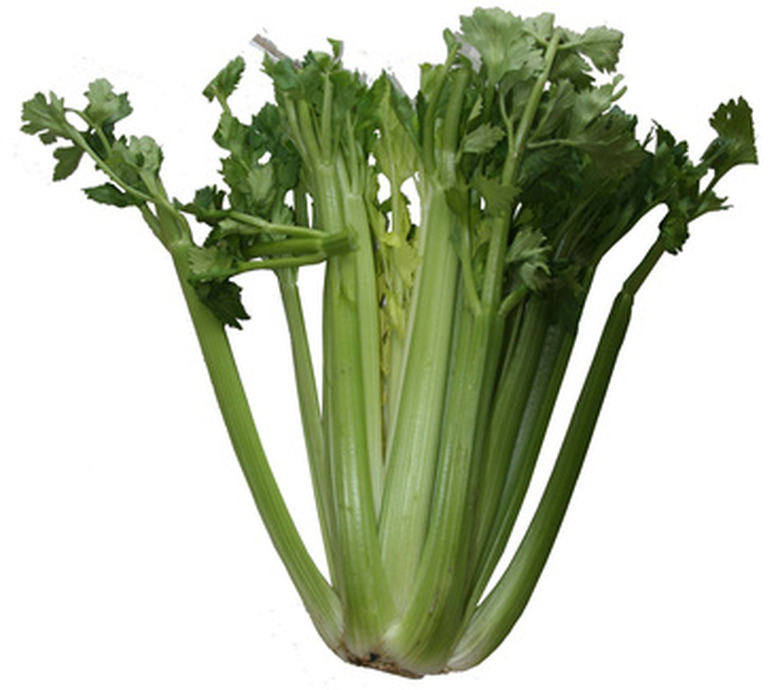Types Of Plant Diseases In Celery
Frost-tender and slow-growing, celery plants are susceptible to a wide range of diseases. Celery takes about five months to mature. Celery can become infected by both viruses that are caused by bacteria and diseases caused by fungi. Most celery diseases are difficult or cost-prohibitive to treat, resulting in loss of the crops.
Leaf Blights
Caused by the harmful fungi Cercospora apii or Septoria apiicola, leaf blight diseases are most prevalent in celery plants during wet conditions. The fungi can over-winter on infected seeds or diseased plant parts, spreading readily from plant to plant. Cercospora blight causes yellow spots on both sides of the celery plant's leaves. As the spots expand, they turn grayish and develop a dry, papery texture. These spots can also occur on the stalks. Septoria blight causes similar yellow spots that turn grayish, but the spots are usually ringed with darker-colored margins and have tiny black specks within the leaf spots.
- Frost-tender and slow-growing, celery plants are susceptible to a wide range of diseases.
- Cercospora blight causes yellow spots on both sides of the celery plant's leaves.
Aster Yellows Mycoplasma
Transmitted by the aster leafhopper, aster yellows mycoplasma is a disease that causes bright yellow discoloration and stunted growth in celery plants. Controlling this disease is difficult, but the typical treatment is to apply insecticidal sprays to control the aster leafhopper population.
Yellows Diseases
Yellows are diseases caused by the fungi Fusarium oxysporum and Fusarium apii. Yellows cause the celery plants to become brittle, bitter-tasting, and rotted in the roots and crowns. The inner plant tissues may turn yellowish-brown to red. Most prevalent during warm weather, the fungus that causes yellows diseases can build up and remain in the soil.
Cucumber and Celery Mosaic Virus
Cucumber mosaic virus causes yellowing and decomposition or necrosis of the leaf veins, as well as slightly sunken lesions that are light-tan on the leaf petioles. Also commonly called southern celery mosaic, this virus causes young celery plants to have stunted growth. Celery mosaic virus produces similar symptoms, but it's transmitted by aphids and causes malformation of young celery plants' foliage, forming cupped leaves.
- Transmitted by the aster leafhopper, aster yellows mycoplasma is a disease that causes bright yellow discoloration and stunted growth in celery plants.
- Celery mosaic virus produces similar symptoms, but it's transmitted by aphids and causes malformation of young celery plants' foliage, forming cupped leaves.
Black-Heart Disease
Black-heart is a disease in celery plants that's caused by a calcium deficiency in the soil. Celery plants with black-heart disease develop water-soaked tips on their young leaves that turn brown and expand to cover all the central leaves. Black-heart disease is most common during drier weather and when potassium levels are much higher than calcium levels.
Pink Rot
Pink rot is a fungal disease that can cause celery plants to suddenly wilt, collapse and die. Caused by the fungus Sclerotinia sclerotiorum, pink rot quickly creates water-soaked, pinkish, rotted areas on the basal crown and leaf petioles. Pink rot typically affects celery plants when conditions are moist and temperatures are cool, usually colder than 77 degrees F. This fungal disease can remain in the soil for several years and can develop a white mold over the rotted celery plant parts.
Bacterial Soft Rot and Rhizoctonia Stalk Rot
Bacterial soft rot causes soft decay and water-soaked plant parts in celery, usually accompanied by a foul odor. This disease is caused by the bacterium Erwinia carotovora and is most prevalent during warm, wet weather. Bacterial soft spot infects celery plants by entering the plant tissues through injured areas or wounds. Rhizoctonia stalk rot, however, is caused by the fungus Rhizoctonia solani and creates rust-red, sunken lesions on the celery plant's stalks and base.
- Black-heart is a disease in celery plants that's caused by a calcium deficiency in the soil.
- Pink rot typically affects celery plants when conditions are moist and temperatures are cool, usually colder than 77 degrees F. This fungal disease can remain in the soil for several years and can develop a white mold over the rotted celery plant parts.
